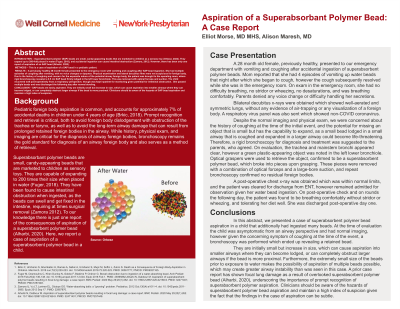Pediatric Otolaryngology
(047) Aspiration of a Superabsorbant Polymer Bead: A Case Report
Monday, October 2, 2023
2:45 PM - 3:45 PM East Coast USA Time

Has Audio

Elliot C. Morse, MD
Otolaryngology Resident
New York Presbyterian Hospital
New York, NY, United States
Alison Maresh, MD
Assistant Professor
Weill Cornell Medicine
New York, New York, United States
Presenting Author(s)
Senior Author(s)
Disclosure(s):
Elliot C. Morse, MD: No relevant relationships to disclose.
Alison Maresh, MD: No relevant relationships to disclose.
Introduction: Superabsorbant polymer (SAP) beads are small, candy-appearing beads that are marketed to children as a sensory toy (Orbeez, 2022). They expand up to 200-fold placed in water (Fuger, 2018), and accidental ingestion can cause intestinal obstruction (Zamora, 2012). However, there has been only one report of aspiration of an SAP bead (Alharbi, 2020).
Methods: This is a case of aspiration of a SAP bead in a pediatric patient.
Results: A previously healthy 28-month female presented to the emergency room with vomiting and coughing after SAP bead ingestion. She had multiple episodes of coughing after vomiting, with no voice changes or dyspnea. Physical examination and lateral decubitus films were not suspicious for foreign body. Due to the history of coughing and concern for the expansile nature of the potential airway foreign body, the patient was brought to the operating room, where rigid bronchoscopy revealed a 0.5 cm SAP bead firmly lodged in the left lower bronchiole. This was removed with optical forceps and suction. The child recovered well post-operatively from a respiratory perspective, though was kept inpatient for monitoring given potential for intestinal obstruction. She passed multiple beads and was discharged the following day after normal stooling.
Conclusions: SAP beads are easily aspirated. They are initially small but increase in size, which can cause aspiration into smaller airways where they can become lodged, or can completely obstruct larger airways if the bead is more proximal. Clinicians should be aware of the hazards of SAP bead aspiration and maintain a high index of suspicion.
